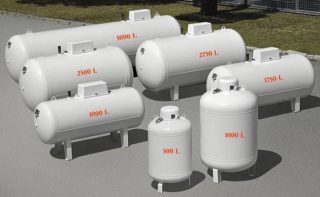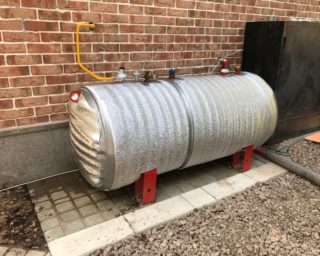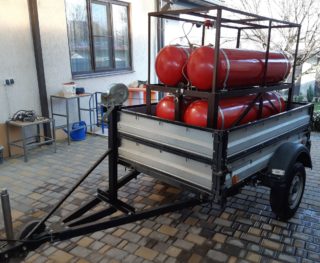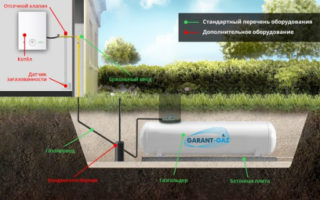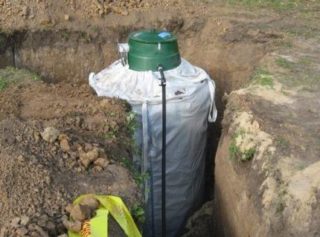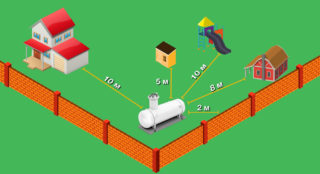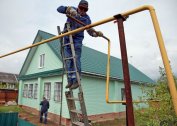In some cases, a gas holder for a private home is the only way to use gas - a convenient and cheap energy source. The facility is needed to store liquefied gas, which is used for heating and cooking. Making the final decision on the installation of equipment, you need to familiarize yourself with the types of storages, the rules for their installation and maintenance.
General information
The gas holder is special autonomous containers for storing large volumes of gases in private homes and industrial enterprises. In addition to the tank itself, the installation includes regulatory, safety and distribution equipment.
The equipment allows you to refuse to connect to the main gas pipelines. This decision is appropriate when gasification from centralized networks is impossible or economically impractical.
For domestic purposes, refueling gas tanks is carried out with a mixture of propane and butane.
The industry produces devices with capacities from 2500 to 20,000 liters.
Gas holders for a country house vary in design, installation method, and functionality.
Before buying, they are determined with the volume of capacity, the cost of equipment and installation work. Choose an acceptable placement option on the site.
Principle of operation
For the functioning of domestic heating boilers, stoves and water heaters, a gaseous fraction of a mixture of propane and butane is used. Fuel to save space is stored in a liquefied state. One liter of liquid propane-butane during evaporation occupies a volume of 0.26 m3, i.e. increases in volume by about 260 times.
The mixture is delivered to the site and pumped to the gas tank. Capacity is filled no more than 85%. During the evaporation of liquid gas in the free part, an air-gas mixture is formed. Evaporation is possible only at temperatures above 0 ° C, which imposes requirements on the installation method and the composition of additional equipment. The gas mixture is piped to consumer appliances.
Delivery and refueling are carried out by licensed companies on special vehicles.
Design and equipment
The classic design of gas holders for the home consists of a metal tank and additional equipment.
Some factories make gas holders from polymer materials. They are more convenient in delivery and installation due to low weight, but more expensive than metal analogues of the same volume.
In the upper part of the tank there is a neck, which is designed for refueling and gas intake for consumers. It sometimes mounts the necessary equipment. Russian-made gas holders, as a rule, have a longer neck. This allows you to bury the tank deeper into the ground, which is important in frosty winters.
At the bottom there are brackets for installing and fixing the tank to the surface.
Depending on the purpose and model, manufacturers equip gas tanks:
- valves for filling, gas intake and safety;
- level meter for monitoring gas residues;
- pressure gauge to ensure safety and adjust the modes of use;
- pressure regulating pressure regulator, safe for operation of boilers, furnaces;
- condensate collector and waste valve.
Depending on the installation method, additional evaporator tanks can be installed.
Manufacturers have developed and produced various models of equipment designed for different installation schemes. Equipment designs also vary. The range can be classified according to the intended installation location and spatial location.
Mobile and stationary models
On sale there are mobile and stationary models. The choice is made based on the tasks being solved.
A mobile version is produced on the chassis of automobile trailers. In most cases, this installation is considered as a temporary option for construction in progress or for use in the country.
Advantages and cases when a mobile model is beneficial:
- savings on installation work;
- the construction of the house is not completed or the place on the site where the stationary model will be installed is not determined;
- there is no space for installing a stationary type gas holder;
- in the short term, it is expected to bring in a settlement or to the house of the main gas pipeline.
Disadvantages of mobile models:
- due to the small capacity, you will often have to visit a gas station in the cold season;
- you will need a car with a tow hitch, which requires insurance of a higher cost;
- the trailer is a vehicle, it must be registered with the traffic police and pay taxes;
- inconvenience to use - in cold weather, heating is required to evaporate the gas;
- the cost of gas for a mobile installation is about 30% higher than for a gas tank on the site;
- increased danger due to detachable connections.
The total cost of using mobile models is higher than fixed installations. You need to use them only when it is really necessary.
Ground and underground installation
When designing gas supply, you need to decide how to install the equipment: on the surface of the earth or in a dug pit. Each option has its own advantages and disadvantages.
Outdoor gas tank
The equipment installed on the surface of the earth has significant advantages:
- for street models, you do not need to dig a pit and pay for earthwork for further improvement of the site;
- corrosion processes take place under the ground actively, therefore protection against them will require additional material investments;
- surface installation is the only option in the case of high groundwater on the site.
Cons of ground gas tanks:
- increased safety requirements entailing an increase in the cost of installation works and equipment;
- the complexity of thermal insulation - when the air temperature decreases, the transition of the liquid fraction to the gaseous state slows down, the pressure in the supply pipe system drops, gas boilers stop working;
- difficulties in placing large-scale gas holders in small areas; the ability to plan a site based on landscape preferences decreases.
Ground tanks are a good option for small-sized houses, when there is no need for a large storage facility.
Underground option
At low additional cost, tanks installed underground have many advantages:
- stable operation in any climatic conditions - the temperature of the surrounding space does not change sharply and does not fall to critical values for the evaporation process;
- increased safety - with a gas leak, the probability of an explosion is minimal;
- there is free space above the tank.
The negative sides are associated mainly with general construction and earthworks:
- digging a pit for large gas tanks will require work on a site of heavy construction equipment, the excess land will have to be taken out somewhere;
- the need to equip a reliable pillow under the tank;
- increased requirements for anti-corrosion treatment;
- on clay soils protection against movement is necessary.
With all the minuses, the additional costs pay off due to ease of use, safety, and the absence of additional equipment on the surface.
Vertical and horizontal orientation
Depending on the individual characteristics of the site, the tasks being solved for gas supply, the installation of the gas tank can be carried out in different planes.
Vertical models
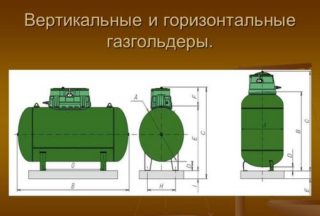 For surface installation, vertical models are often used - they take up less space on the site.
For surface installation, vertical models are often used - they take up less space on the site.
With low power consumers, the vertical type is more suitable, since the pressure in the system is more stable.
At the same time, a small “mirror” of evaporation does not allow to obtain the required amount of a gaseous mixture for powerful equipment. Particularly noticeable is a shortage in winter, when more fuel is required.
To solve the problem, additional equipment is installed:
- heaters consuming electricity;
- additional evaporator tanks.
Additional structural elements increase its cost, installation and commissioning costs. In addition, the more equipment, the higher the risk of breakdown of one of the elements.
Vertical installations are better suited for southern regions.
Horizontal installation
Installation of horizontally oriented gas holders is preferable for cold regions and often the only possible option for houses of large area.
Advantages of horizontal models:
- high productivity due to increased evaporation area;
- minimum of additional equipment to ensure the required gas supply parameters;
- increased dimensions increase the length of the period between refueling;
- large capacity of underground installation gas holders while saving useful area of the site.
Negative points:
- large footprint with ground installation;
- a large amount of earthwork;
- the high cost of high neck equipment for deep installation.
The decision which type of installation to choose is made on the basis of a comprehensive analysis of specific operating conditions.
Installation procedure
The installation and commissioning of a gas tank for a house or a summer house consists of the following steps:
- preparatory, including system design and equipment purchase;
- connecting gas consuming equipment.
Legal issues
Registration with supervisory authorities is subject to containers for storing gases more than 100 liters. A gas holder is never less than 450 liters. However, registration and registration requirements apply only to legal entities and individual entrepreneurs.
For the installation of a gas tank without registration to date, no penalties are provided. What legislative decisions will be made in the near future is unknown.
Design and purchase of equipment
Designing a project is best entrusted to an organization licensed for this type of activity. Only highly qualified specialists can accurately calculate the equipment parameters and draw up a safe gasification scheme for a private house.
Based on the specification, equipment is selected and purchased. It is worth giving preference to large companies - their equipment is cheaper, warranty repair is easier to achieve than for small one-day firms.
Calculation of the volume of the gas tank
The consumption of the gas mixture is not constant throughout the year and depends on the street temperature, the method of installation of the gas tank, individual preferences for the level of comfortable temperature in rooms and utility rooms, and the quality of insulation of building structures.
According to statistics compiled by organizations operating individual gas supply systems, on average, only 25 liters of gas per year are consumed on average for heating only one square meter of a house.
For housing with an area of 100 m2, you need a capacity of 2500 liters. Taking into account the work of a gas stove and a water heater in the warm season, a margin of 10% should be made. Possible extremely low temperatures are taken into account when more fuel is needed. Consequently, it is necessary to purchase a gas tank of 3000 liters if refueling is carried out once a year.
To save money, given the seasonal fluctuations in gas prices, it is advantageous to refuel the gas tank 2 times a year. In this case, you can purchase a 2000 liter installation.
Calculations are approximate for the whole country, it is better to find out the exact numbers from neighbors using such equipment, or from local specialized organizations.
Placement requirements
The place for mounting the gas tank on the site is selected based on the requirements of SNiP and fire safety rules.
Fundamental rules:
- it is necessary to arrange a paved driveway for the tanker and fire trucks;
- the foundation is made of finished reinforced concrete slabs or poured with reinforced concrete with a thickness of at least 16 cm;
- to open reservoirs the distance should be at least 50 m;
- to infrastructure elements and neighboring sections of at least 10 m with a gas holder volume of up to 10 m3 and 20 m with a capacity of more than 20 m3;
Farm buildings should not be located above the gas tank.
Irrigation lawns cannot be organized due to increased corrosion of the underground parts.
Mounting Features
For proper installation, you should study the documents:
- SP 62.13330.2011;
- SP 42-103-2003;
- SP 31-106-2002;
- PB 03-576-03;
- Federal Law of the Russian Federation N 123-ФЗ.
Studying all the rules and observing the requirements yourself is a difficult task. Install a gas tank and carry out further maintenance is entrusted to a specialized organization.
In accidents and fires, property, including neighbors, may be damaged.
The owner of the gas tank will be liable for poor-quality service that caused damage to another's property if there is no service contract.
For the installation of a gas holder, it is mandatory to mount to a concrete base. For outdoor systems, this will ensure structural stability and reduce the risk of tipping over in strong winds. Underground tanks are also necessarily attached to the pillow. Otherwise, when groundwater appears, the tank will pop up, destroying the pipelines.
Installation of supply pipes is carried out at a depth of not less than 1.5 m, and the slope should not exceed 1%. Mandatory installation of a condensate collector with the possibility of cleaning it.
The top point of the tank must be at least 60 cm below the ground. The control, shut-off, safety valves are mounted above ground level.
A gas holder is a complex and dangerous device that requires increased attention during operation. Subject to all installation and maintenance rules, it will allow you to safely use the convenience of gas heating in private homes and cottages.
